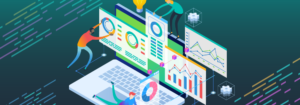This blog is first installment of a two-part series and will explore the best ways for individuals to stay focused as a way to avoid creating a “data dumpster.” The second post will examine the data needs of key stakeholders within a provider organization, including executive leadership, research and industry experts, analysts, front-line staff and operational decision makers.
Analytics programs are becoming a huge priority for healthcare organizations, according to a recent industry survey. As such, we are seeing a pattern where healthcare professionals often try to extract as much data as possible from multiple sources. The purpose of having this information is to save time and avoid having to involve a whole slew of IT support folks. Yet, much of this data is often unused and prevented from entering an analytics engine. The New England Journal of Medicine recently published a paper on this trend, likening the data hoarding to the creation of “data dumpsters,” or repositories that lack metadata or documentation to put information into context.
To address this growing issue and to make the most of valuable data, it is important that providers focus and ensure that all stakeholders within the organization understand how they can use data analytics.
How to Avoid Diluting Focus
Understand that your managers already use up all of the time in their day (usually above and beyond the mythical 40 hour work week). Therefore, every minute looking at data and trying to interpret large tables comes at a cost. Although buried in each one of those data sets are plenty of fascinating “insights” and intriguing projects, they don’t move the needle on the important strategic priorities. To avoid diluting focus, consider the follow suggestions.
- Define what is important to you as an organization. Hold team members accountable to these numbers.
- Present “success” realistically using benchmarking and understand the 80/20 rule. Is it worth spending a lot of effort to lower your Days in AR when you are already at the 90th percentile nation-wide?
- Quantify “insights” in terms of bottom line impact. Work on the projects that have the “biggest bang for the buck.” Advanced analytics can help quantify the opportunity available in a number of areas. Direct your focus to areas where there is fat to be cut.
- Consider hypotheticals. Imagine that you discovered what you were looking for. Then what? If you don’t know how to translate your hypothetical insight into action, there is no chance that real insight from further analysis is worth your time.
For more details on understanding data consumers and their data needs within an organization, from executives to front line staff, tune back in to the second of this two-part blog series later this month
Get our take on industry trends
Pandemic fuels 2021 healthcare megatrends
When I wrote about megatrends last year, the predictions were, naturally, forward-looking. Telehealth, for example, was important because of increased healthcare consumerism and the convergence of technologies to make its use quick and easy for payers, providers and patients.
Read on...Measuring provider cost and utilization
No matter the time of year, payers and providers should work to agree on a shared source of truth when it comes to data. With the recent end of the year, it’s time to celebrate the new year (who isn’t ready to say goodbye to 2020?) and close the books, which includes the reconciliation of any shared savings or losses.
Read on...Data visualization: A picture is worth a thousand…healthcare data points?
The amount of data produced daily has grown exponentially with nearly 90% of the world’s data generated in the last two years alone. To ensure we can make sense of this data, analysts must find meaningful ways to present the information to their audiences.
Read on...Crystal ball not necessary: predictive analytics helps health systems reduce denials
The idea of having a crystal ball to better understand what claims will be denied is an awesome concept. But one we can’t rely on. Thankfully, we have predictive analytics to take the place of a crystal ball.
Read on...


